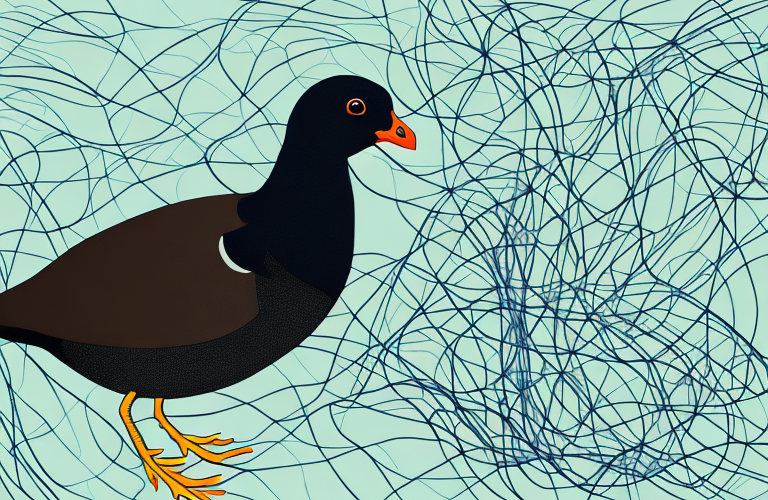Welcome to our comprehensive guide on the Common Moorhen. In this article, we will explore various aspects of these fascinating birds, including their physical description, habitat, behavior, diet, reproduction, vocalizations, predators, conservation efforts, and more. Whether you are a bird enthusiast or just curious about these species, you are in for an informative journey. So grab a cup of tea and let’s dive into the world of the Common Moorhen.
Introduction to the Common Moorhen
The Common Moorhen, scientifically known as Gallinula chloropus, is a medium-sized waterbird belonging to the Rallidae family. With its distinctive red frontal shield and long, yellow legs, the Common Moorhen is easily recognizable. These birds are prevalent in wetland habitats, including marshes, swamps, lakes, and ponds across Europe, Asia, Africa, and the Americas. Known for their adaptability and resourcefulness, Common Moorhens have successfully colonized a wide range of habitats around the world.
Common Moorhens are primarily herbivorous, feeding on a variety of aquatic plants, seeds, and fruits. They also consume small invertebrates, such as insects and snails, supplementing their diet with animal protein. Their foraging behavior involves walking on floating vegetation or swimming in shallow water, using their long toes to help them balance.
During the breeding season, Common Moorhens build nests in dense vegetation near the water’s edge. The nests are constructed using a combination of twigs, reeds, and other plant materials. Both the male and female birds participate in nest building, with the male often collecting the materials and the female arranging them. The female typically lays a clutch of 6-12 eggs, which are incubated by both parents for about three weeks. Once hatched, the chicks are precocial, meaning they are able to leave the nest and swim shortly after hatching.
Physical Description of the Common Moorhen
The Common Moorhen measures around 30-38 centimeters in length and weighs approximately 300-500 grams. They have a compact body structure, with short wings that enable swift and agile movement through dense vegetation. While their feathers appear mostly black from a distance, a closer look reveals a dark blueish-purple plumage that shimmers when illuminated by sunlight. One of the most striking features of the Common Moorhen is its vibrant red frontal shield, which serves as a visual cue during courtship displays and territorial disputes. Additionally, these birds possess a sharp, pointed beak ideal for foraging in water and mud.
The Common Moorhen is a highly adaptable bird that can be found in a variety of wetland habitats, including marshes, ponds, and lakes. They are excellent swimmers and are often seen diving underwater to search for food. Their diet primarily consists of aquatic plants, insects, small fish, and amphibians. Common Moorhens are known for their territorial behavior, defending their nesting sites and foraging areas from intruders. During the breeding season, they build floating nests made of reeds and vegetation, hidden among dense vegetation near the water’s edge. Both parents take turns incubating the eggs and caring for the chicks until they are old enough to fend for themselves. Despite their name, Common Moorhens are not actually moorhens, but rather belong to the rail family. They are widespread and can be found in many parts of the world, including Europe, Asia, Africa, and the Americas.
Habitat and Distribution of the Common Moorhen
The Common Moorhen exhibits a wide distribution range, populating various wetland habitats worldwide. In Europe, they can be found from Scandinavia down to the Mediterranean region. In Asia, their range extends from the Middle East to the Far East, including India and China. In Africa, Common Moorhens are abundant throughout the continent, while in the Americas, they inhabit regions from southern Canada all the way down to Argentina.
Within their preferred wetland habitats, Common Moorhens tend to seek out dense vegetation such as reeds, cattails, and water lilies. These plants provide them with ample cover and nesting sites, as well as a bountiful supply of food. The presence of freshwater sources, including lakes, ponds, and slow-moving rivers, is crucial for their survival.
Common Moorhens are highly adaptable birds and can be found in a variety of wetland habitats, including marshes, swamps, and even urban ponds. They are known to thrive in both natural and man-made environments, making them a common sight in parks and gardens with suitable water bodies.
Behavior and Social Structure of the Common Moorhen
Common Moorhens are generally social birds that form loose colonies within their wetland habitats. While they often forage individually, you can spot them gathering in groups during the breeding season. These groups consist of several pairs and occasionally include non-breeding individuals.
When it comes to territorial behavior, Common Moorhen males vigorously defend their respective territories, which encompass a suitable nesting site and a sufficient food supply. Females play an essential role in choosing the nesting location, evaluating the male’s ability to provide and protect.
Interestingly, Common Moorhens are known to exhibit aggressive behavior towards individuals invading their territories. You may witness dramatic behaviors, such as territorial disputes involving intense chasing, wing flapping, and pecking. However, these conflicts rarely result in severe injury and are primarily displays of dominance.
During the breeding season, Common Moorhens engage in elaborate courtship displays to attract a mate. These displays often involve the male puffing up his feathers, bobbing his head, and making a series of calls to signal his availability and fitness. The female will assess the male’s displays and choose a mate based on his performance.
Once a pair has formed, they will work together to build a nest. Common Moorhens construct nests made of vegetation, typically in dense vegetation near the water’s edge. The female takes the lead in nest building, while the male assists by bringing materials to the female. The nest is usually a floating platform, anchored to surrounding vegetation to prevent it from drifting away.










